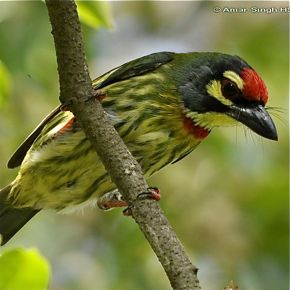“There were five Coppersmith Barbets (Megalaima haemacephala indica) feeding at one time, either as family or just attracted at the same time. At least two were mature adults, and two immature developing adult plumage,” wrote Dato’ Dr Amar-Singh HSS on the fruiting Ficus benjaminaa tree near his home in Ipoh, Perak, Malaysia on 17th July 2010.
The image above-left shows a mature adult with adult plumage. The immature shows the red plumage on the forehead and neck and the rich green on the back not well developed (above right).
As noted earlier, the Coppersmith Barbet first crushes the fig and then processes it by mashing it up, before swallowing (below). “Occasional they ‘regurgitate’ to mash a bit more before swallowing,” added Amar











